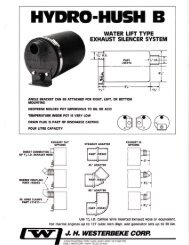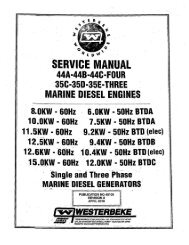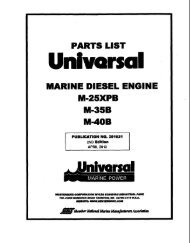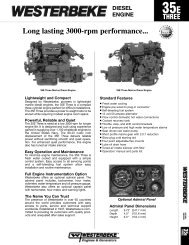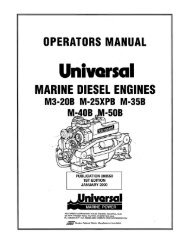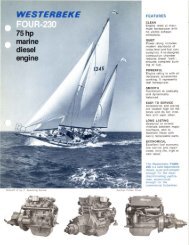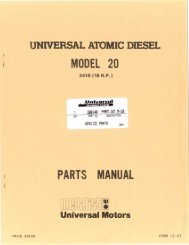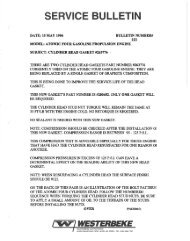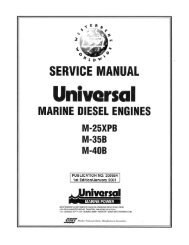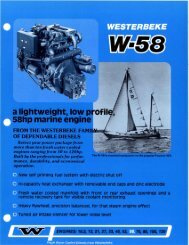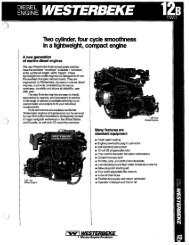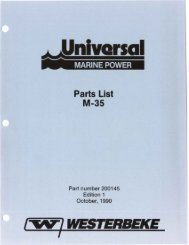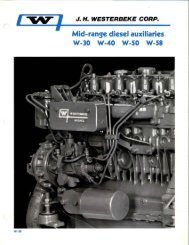service manual 44240 8.0, 10.0, 12.5 and 15.0 - Westerbeke
service manual 44240 8.0, 10.0, 12.5 and 15.0 - Westerbeke
service manual 44240 8.0, 10.0, 12.5 and 15.0 - Westerbeke
Create successful ePaper yourself
Turn your PDF publications into a flip-book with our unique Google optimized e-Paper software.
DISASSEMBLY AND ASSEMBLY PROCEDURES<br />
DISASSEMBLY<br />
• Before disassembly <strong>and</strong> cleaning, carefully check for<br />
defects which cannot be found after disassembly <strong>and</strong><br />
cleaning.<br />
• Drain water, fuel <strong>and</strong> oil before disassembly.<br />
• Clean or wash the engine exterior.<br />
• Do not remove or disassemble parts.<br />
• Perform disassembly in a proper order using proper tools.<br />
Keep disassembled parts in order. Apply oil when<br />
necessary. Take special care to keep the fuel system parts<br />
from intrusion of dust <strong>and</strong> dirt.<br />
• Parts must be restored to their respective components from<br />
which they were removed at disassembly. This means that all<br />
parts must be set aside separately in groups, each IIllIIked for<br />
its component, so that the same combination or set can be<br />
reproduced at assembly.<br />
• Pay attention to marks on assemblies, components <strong>and</strong><br />
parts for their positions or directions. Put on marks, if<br />
necessary, to aid assembly ..<br />
• Carefully check each part or component for any sign of<br />
faulty condition during removal or cleaning. The part will<br />
tell you how it acted or what was abnormal about it more<br />
accurately dm!ng removal or cleaning.<br />
ASSEMBLY<br />
• Wash aU parts, except for oil seals, O-rings,<strong>and</strong> rubber<br />
gaskets with cleaning solvent <strong>and</strong> dry them with air<br />
pressure .<br />
• Always use tools that are in good condition <strong>and</strong> be sure<br />
you underst<strong>and</strong> how to use them before performing any<br />
job.<br />
• Use only good quality lubricants. Be sure to apply a coat<br />
of oil, grease or sealant to parts as specified ..<br />
• Be sure to use a torque wrench to tighten parts for which<br />
torques are specified.<br />
• When the engine is assembled,install new gaskets <strong>and</strong><br />
O-rings.<br />
TORQUING DATA<br />
Parts of the engine use plastic region tightening bolts. The<br />
tightening procedure for these is different from that of<br />
conventional bolts <strong>and</strong> is described in this <strong>manual</strong>, Note that<br />
plastic region tightening bolts have fixed <strong>service</strong> limitS.<br />
These limits are indicated in this <strong>manual</strong> <strong>and</strong> must be strictly<br />
observed.<br />
• Plastic region tightening bolts are used for the following<br />
applications:<br />
1. Cylinder head bolts<br />
2. Connecting rod cap bolts<br />
• The tightening procedure is basically as follows: After<br />
tightening a bolt to the specified torque, tighten it by a<br />
further 90" + 90" or by a further 90-100". The exact<br />
tightening procedure differs depending on the bolt <strong>and</strong> is<br />
described where it applies in this <strong>manual</strong>.<br />
".. WESTERBEKE<br />
Engines & Generators<br />
8<br />
GASKET INFORMATION<br />
The engine has several areas where form-in-place RTV<br />
silicone gaskets are used such as LOCTITE 598 or GE<br />
RTV 100. To ensure that the gasket fully serves its pmpose,<br />
it is necessary to observe some precaution when applying the<br />
gasket. Bead size, continuity <strong>and</strong> location are very important.<br />
Too thin a bead could cause leaks <strong>and</strong> too thick a bead could<br />
be squeezed out of location causing blocking or narrowing of<br />
the fluid feed lines. To eliminate the possibility of leaks from<br />
a joint, it is necessary to apply the gasket evenly without a<br />
break while observing the correct bead size.<br />
The gasket material used in the engine is a room temperature<br />
vulcanization (RTV) type <strong>and</strong> is supplied in a l40z (400<br />
gram) applicator/tube. The RTV hardens as it reacts with the<br />
moisture in the atmospheric air <strong>and</strong> can be used for sealing<br />
both engine oil <strong>and</strong> coolant assemblies.<br />
Disassembly<br />
The parts assembled with the silicone can be easily<br />
disassembled without use of a special method. In some cases,<br />
however, the sealant between the joined surfaces may have<br />
to be broken by lightly striking with a mallet or similar tool.<br />
A flat <strong>and</strong> thin gasket scraper may be lightly hammered<br />
in between the joined surfaces. In this case, care must be<br />
taken to prevent damage to the joined surfaces. For removal<br />
of the oil pan, use a special "oil pan remover".<br />
Surface Preparation<br />
Thoroughly remove all substances deposited on the gasket<br />
application surfaces using a gasket scraper or wire brush.<br />
Check to ensure that the surfaces to which the silicone gasket<br />
is to be applied is flat. make sure that there are no oils,<br />
greases <strong>and</strong> foreign substances deposited on the application<br />
surfaces. Do not forget to remove the old sealant that<br />
remains in the bolt holes.<br />
Form-in-place Gasket Application<br />
When assembling parts with the silicone gasket, you must<br />
observe some precautions but the procedures are very simple<br />
as in the case of a conventional precut gasket.<br />
The applied gasket bead should be the specified size <strong>and</strong><br />
without breaks. Be sure to encircle the bolt hole circumference<br />
with a completely continuous bead. The gasket material<br />
can be wiped away unless it has hardened. While the gasket<br />
is still moist, mount the parts in position. When the parts are<br />
mounted, make sure that the gasket is applied to the required<br />
area only. Do not apply oil or water to the sealing locations<br />
or start the engine until a sufficient amount of time has<br />
passed after installation is completed.<br />
The gasket application procedure may vary on different<br />
areas. Observe the procedure described in the text when<br />
applying the gasket silicone <strong>and</strong> follow the directions on the<br />
applicator/tube.



